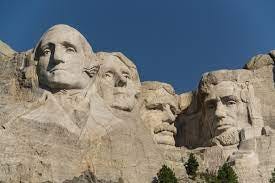Mount Rushmore National Memorial in South Dakota features 60-foot visages of George Washington, Thomas Jefferson, Abraham Lincoln and Teddy Roosevelt. Over 75 years ago, its creator, Gutzon Borglum, declared his contribution to saluting America’s greatness but there is another lesser told story behind the creation.
Before it was Mt. Rushmore, it was known as The Six Grandfathers (Tȟuŋkášila Šákpe). It was named by Lakota medicine man Nicolas Black Elk after a vision of the six sacred directions: west, east, north, south, above, and below representing the traits of loving grandfathers including kindness, love, age, and wisdom. The original granite bluff was naturally formed by the wind and rain until 1927 when construction on Mt. Rushmore began. This was one more cost of colonization for the Lakota people.
The faces of George Washington, Thomas Jefferson, Theodore Roosevelt, and Abraham Lincoln were chosen for the memorial. However, each of these presidents represented oppression for the Indigenous people and African Americans. Washington and Jefferson were prominent slaveowners and Roosevelt said: “the only good Indian is a dead Indian.” On the day after Lincoln signed the Emancipation Proclamation, he ordered the 1862 public execution by hanging of 38 Dakota men at Fort Snelling in Minnesota.
The elderly president of the United Daughters of the Confederacy, C. Helen Plane, approached Borglum in 1914 about building a “shrine to the South” near Atlanta on Stone Mountain. Borglum later recalled, “I saw the thing I had been dreaming of all my life.” The sculptor from Connecticut had no ties to the Confederacy but eagerly accepted the invitation and provided a sketch of generals Robert E. Lee and Stonewall Jackson and was hired.
A son of polygamist Mormons from Idaho, Borglum embraced white supremacist views. He feared a. perceived threat to white purity and aligned himself with the Ku Klux Klan (KKK) in a torch-light ceremony atop Stone Mountain in 1915. The KKK contributed to the funding of Borglum’s sculptor on Stone Mountain. However, KKK infighting led to the stalling of funding for the memorial in the mid-1920s. When a South Dakota historian approached Borglum about the Mt. Rushmore project at that time, he was fired from the Stone Mountain project.
Borglum began carving Mt. Rushmore in 1927 at the age 60 and devoted the last 14 years of his life to the project with his son, Lincoln, performing finishing touches.
Cited from:
Hope, N. (n.d.). The six grandfathers before it was known as Mount Rushmore. The Six Grandfathers Before It Was Known as Mount Rushmore. Retrieved from https://blog.nativehope.org/six-grandfathers-before-it-was-known-as-mount-rushmore?fbclid=IwAR2vW66m-KGHQ-mI44GW1FROcdUO0cK3BsC4io86DEhr0aMzi8qMF3j-Fxw.
Shaer, M. (2016, October 1). The sordid history of Mount Rushmore. Smithsonian.com. Retrieved from https://www.smithsonianmag.com/history/sordid-history-mount-rushmore-180960446/?fbclid=IwAR3RHnsGUx1qosIRShTWc2t__jMkNlIZEalOJ1l-i1e0TxvxuXYxkI-EcVo.




